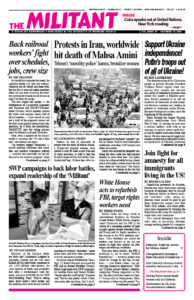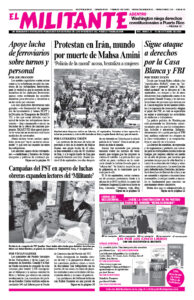Millions of working people in the U.S. and worldwide stand with protesters across Iran in response to the death of Mahsa Amini, a Kurdish woman who died in the hands of the reactionary regime’s notorious “morality police.” She was arrested on charges of running afoul of the restrictive dress codes the government imposes on women. Thousands continue to protest despite the brutal response of the rulers’ repressive forces that has left 41 demonstrators dead.
These are the biggest actions in Iran since protests in 2019 that followed a sharp rise in gas prices. Those demonstrations were fueled by mounting opposition to the Iranian rulers’ military and political interventions across the Middle East and their consequences at home. The deadly cost of Tehran’s expansionist foreign policy, like its bombardment this week of the Kurdish region of Iraq, falls squarely on working people.
U.S. media claim the Iranian regime’s reactionary policies are a result of the revolution that overturned the dictatorial rule of the U.S.-backed shah of Iran. “In the wake of the Islamic revolution in 1979, revolutionaries forced women to wear scarves in public,” wrote Najmeh Bozorgmehr in the Financial Times.
This turns facts on their head. Women were a powerful part of the uprising and battles afterward to advance the struggles of the working class, oppressed nationalities and their own rights. Laws forcing women to wear the hijab were imposed by counterrevolutionaries as part of their drive to overturn advances made in the 1979 revolution and to reinforce capitalist rule.
In factories and oil refineries workers set up shoras, workers councils, to combat capitalist sabotage and fight for workers control of production. Women were part of these battles, joining peasant struggles for land and demanding military training so they could join in the war against the U.S.-backed Iraqi invasion in 1980.
One day after Ayatollah Ruhollah Khomeini ordered women government workers to wear the veil at work, the largest International Women Day’s march worldwide took place in Tehran on March 8, 1979. When rightist thugs attacked demonstrators, larger protests against Khomeini’s decree were organized. “To deny women freedom, is to deny freedom to the rest of society,” chanted 15,000 in Tehran. Khomeini was forced to back down. Women won the right to dress as they please and to participate in and hold office in the shoras.
Tehran’s clerical rulers couldn’t make their anti-women restrictions law until 1983, part of a broader counterrevolution that targeted workers and farmers and oppressed peoples like the Kurds. They were finally able to consolidate a Shiite-based clerical capitalist regime that continues to hold power.
The resistance by working people to that government’s assaults has exploded so widely today because of underlying opposition to the regime’s brutality at home and abroad. This is an integral part of struggles by working people worldwide to defend the political space and freedoms we need to organize and fight.
It underlines why the fight for women’s emancipation is in the interests of all working people and will be central to working-class battles that lie ahead.

